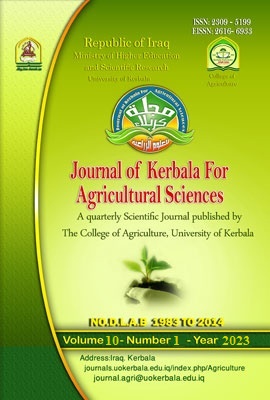Effect of cultivars and split application of nitrogen at the different growth stages on yield and its component of bread wheat (Triticum aes-tivum L.) under rain-fed conditions in Kurdistan, Iraq
DOI:
https://doi.org/10.59658/jkas.v10i3.1115Abstract
To investigate the best N fertilizer application regime for the environment and the economy. Therefore, a field experiment was conducted for one year (2020–2021) under the rain-fed condition at two locations in the Sulaimani region; Qlyasan research field of the College of Agriculture Engineering University of Sulaimani and the Kanipanka research station in the Sharazoor valley to determine the effect of the application of 120 kg ha-1 N in four split doses (T6) at four growing stages, sowing, tillering, booting, and spiking, respectively. Were T1 (60 kg ha-1 N at sowing, 60 kg ha-1 N at tillering) used as a control, T2 (60 kg ha-1 N at sowing, 30 kg ha-1 N at tillering, 30 kg ha-1 N at booting), T3 (60 kg ha-1 N at sowing, 30 kg ha-1 N at tillering, 30 kg ha-1 N at spiking), T4 (60 kg ha-1 N at sowing, 20 kg ha-1 N at tillering, 20 kg ha-1 N booting, 20 kg ha-1 N at spiking), T5 (40 kg ha-1 N at sowing,30 kg ha-1 N at tillering, 30 kg ha-1 N at booting, 20 kg N ha-1 N at spiking) and T6 (40 kg ha-1 N at sowing, 40 kg ha-1 N at tillering, 40 kg ha-1 N at booting) and their effect on grain yield and it’s components of bread wheat cultivars (Adana-99, Hawler-4, and Sulaimani-2). A split plot arrangement within Randomimized Complete Block Design with three replicates was used. The possible comparison among the means was calculated following the Duncan test at a significant level of 0.05. As part of grain yield, no. of spikes m-2, no. of grains.spike, thousand-grain weight (g) (TGW), grain yield ton ha-1 (GY), biological yield ton ha-1 (BY), and Harvest Index (H.I) were all calculated. As the average of both locations of the results showed that the impact of Cultivars on agronomic traits was significant, Sulaimani-2 produced the maximum values for all characters, with the exception of (TGW) and (H.I), which were provided by Hawler-4. All the bread wheat characters were significantly influenced by the time of application of nitrogen, where T5 produced the maximum value for all characters with the exception no. of spike m-2, where T6 had the ultimate value. The no. of spikes m-2 had a significant effect on the T4, and T5 study characters. Based on what we've found, the best combination is Sulaimani-2 with T6 and T5 except in Qlyasan location with T6 only when rain is guaranteed. This increases both the yield and its components.
Downloads
Published
How to Cite
Issue
Section
License
Copyright (c) 2023 Copyright (c) 2024 is the Author's article. Published by the Journal of Kerbala for Agricultural Sciences under a CC BY 4.0 license

This work is licensed under a Creative Commons Attribution 4.0 International License.
Licensing Terms
All articles are published under a Creative Commons License and will be directed to the Creative Commons Attribution 4.0 International License (CC BY 4.0) That permits use, distribution, and reproduction in any medium, provided the original work is properly cited. This license also allows the work to be used for commercial purposes.
Use by both non-commercial and commercial users
This content is licensed under a Creative Commons Attribution 4.0 International (CC BY 4.0) license, permitting use by both non-commercial and commercial users. Individual users may access, download, copy, display, and redistribute the articles to colleagues, as well as adapt, translate, and text- and data-mine the content, subject to the following conditions:
- The author's moral rights, including the right of attribution and the right to protect their work from derogatory treatment, are respected.
- Where content in the article is identified as belonging to a third party, users must ensure that any reuse complies with the copyright policies of the owner of that content.
- If the article content is reused for research or educational purposes, users should maintain a link to the appropriate bibliographic citation, including the DOI and a link to the published version on the journal's website.






